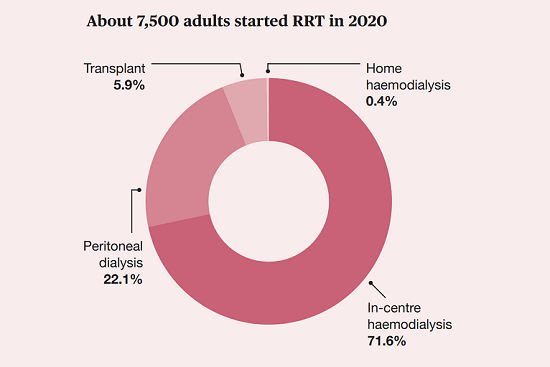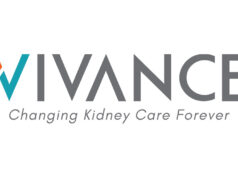
With comprehensive UK Renal Registry (UKRR) data from 2020 set to be published by the UK Kidney Association (UKKA) imminently, Renal Interventions previews a handful of key talking points these figures will likely trigger.
One immediate observation from the 2022 UKRR report, which includes data to 31 December 2020, is that the number of new people starting renal replacement therapy (RRT) for end-stage kidney disease (ESKD) in the UK has decreased compared to previous years. RRT incidence had previously been steadily increasing for several years, but it now appears this reached a peak in 2017. Throughout 2020, 7,373 adults started RRT—an incidence of 139 per million people among adults—compared with 8,070 in 2019 and 8,069 in 2018.
A UKKA spokesperson believes that, while COVID-19 likely played a part here, the exact bearing of the pandemic on these 2020 figures is not clear. They speculate that, at a time when people with long-term conditions were being advised to ‘shield’ themselves, it is likely some patients and clinicians will have tried to delay starting RRT if at all possible.
In addition, COVID-19-related mortality may have resulted in fewer patients actually reaching RRT at all. These speculations are supported by the decrease in incidence being observed almost entirely in those aged >65 years and are borne out further by draft numbers from 2021, which indicate a recovery in RRT incidence rates.
Peritoneal dialysis and other modalities
The 2022 UKRR report is also set to reveal an increase in the proportion of patients receiving peritoneal dialysis (PD) as their initial treatment modality. While the majority of UK patients (72%) still receive in-centre haemodialysis as their initial ESKD treatment, a slight jump from 20.1% to 22.1% in PD does reverse a longstanding trend that has seen its uptake as an initial treatment choice decrease over time.
The UKKA spokesperson speculates that this may have been driven by the logistical advantages and convenience offered by PD within the context of a pandemic, adding that home dialysis recommendations in the recent Getting It First Right Time (GIRFT) national report on renal medicine may help to sustain, or even build on, this increase. UKRR data from 2020 also finds that, with a >15% increase in the proportion of incident dialysis patients starting with PD, centres in London Barts (26%) and Derby (15%) in England, and Wrexham (16%) in Wales, were among the biggest ‘improvers’ across the UK. In addition, three centres in England had a >30% prevalence of home therapies in dialysis patients in 2020: Derby (35%), Stoke (34%) and Shrewsbury (33%).
Another phenomenon revealed by the UKRR report is that the proportion of people who had a kidney transplant by day 90 decreased compared to the previous year—from 9.8% during 2019 to 7.7% during 2020. According to the UKKA spokesperson, this is almost certainly an effect of the disruption COVID-19 caused in transplant pathways.
A further observation from the report is that, from a cohort of 5,242 incident dialysis patients with data, the proportion of people initiating RRT with an arteriovenous fistula/graft (AVF/G) dropped slightly from 35.1% in 2019 to 26.8% in 2020. The UKKA spokesperson believes COVID-19-related disruption to vascular access pathways may have played a role here, but notes it was likely not driven by an increase in late patient presentation, as these figures were not significantly different between 2020 and the previous year.
ESKD growth slows, AKI incidence drops
Overall, the number of people treated for ESKD rose in 2020, as per UKRR data, but this increase was less substantial than in previous years. It is thought that the deaths of dialysis and transplant patients, coupled with a smaller number of new patients, resulted in these numbers increasing marginally, by 0.15% to 68,249 adults (an increase of roughly 100 people), as compared to an otherwise fairly consistent increase of 2.5% each year from 2016 to 2019—mainly led by yearly increases in the number of people with a functioning kidney transplant.
The number of acute kidney injury (AKI) episodes in England also fell during 2020, with roughly 5% fewer episodes being seen across the UKRR data. Some 10,691 episodes per million people occurred in 2020 versus 11,242 in 2019. While severe COVID-19 infection was associated with AKI, especially during the first wave of infections, there was significantly reduced National Health Service (NHS) elective activity during 2020, and the UKKA spokesperson believes this is the likely explanation for the aforementioned decline throughout the year. This speculation is supported by early indications from 2021 data that AKI episode rates increased to more than 11,000 and are approaching prepandemic levels once more.
According to the spokesperson, whether or not these trends will persist is unknown—but the latest UKRR report teaches us that timely data are critical. Throughout 2021, COVID-19 had a considerable and continuous impact on health and healthcare systems. And, in 2022—despite significantly lower rates of severe disease—many treatment pathways remain disrupted. The change in home dialysis rates, and whether this will be sustained, is of particular interest, as is the desire to understand more about the group of ESKD patients who, with their clinicians, choose not to have RRT. The weekly collection and reporting of COVID-19 infections and deaths among those on RRT was critical in influencing UK policymakers to protect ESKD patients, they state, and this has added impetus to the UKRR’s shift towards more ‘real-time’ data collection coupled with a timely summary of results.
More information on this, as well as the UK Renal Data Collaboration (UKRDC), are available on the UKKA website, and the latest UKRR report will be published in full in June 2022.










